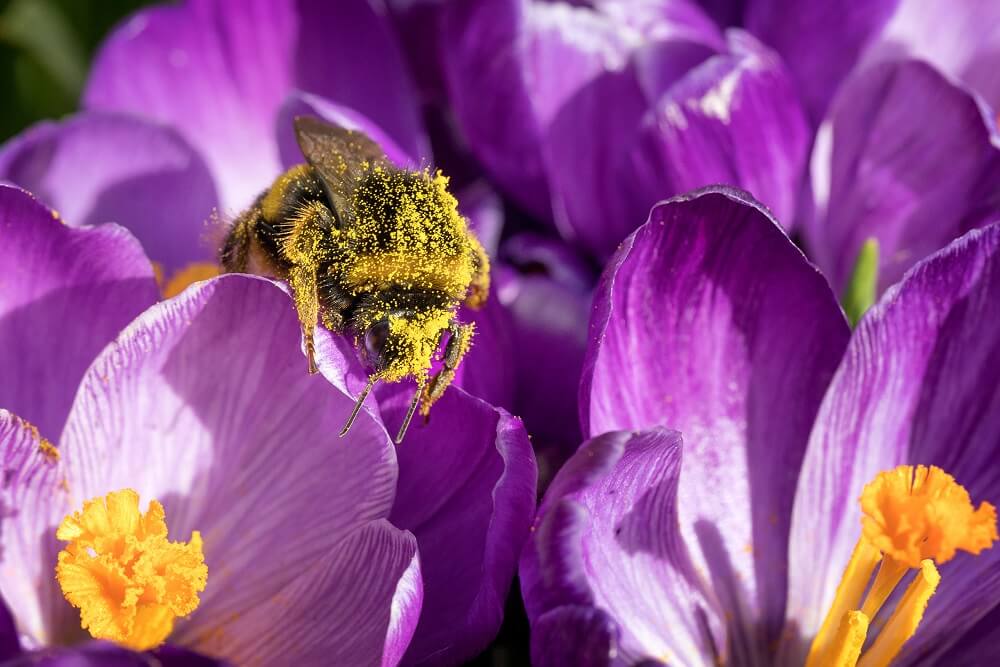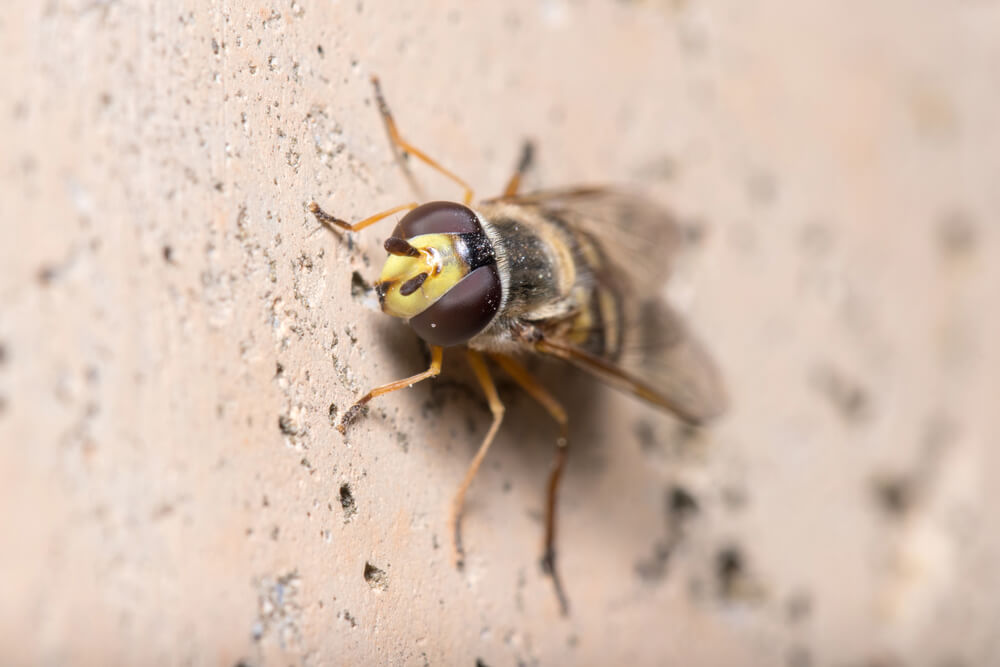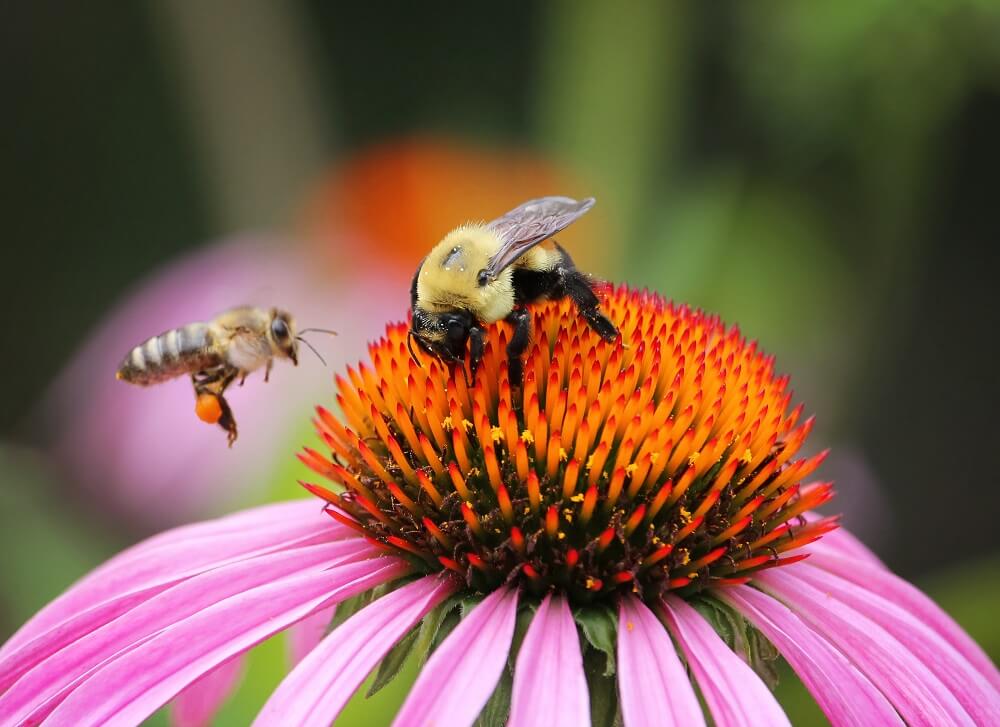Table of Contents:
What Do Bees Use Pollen For?
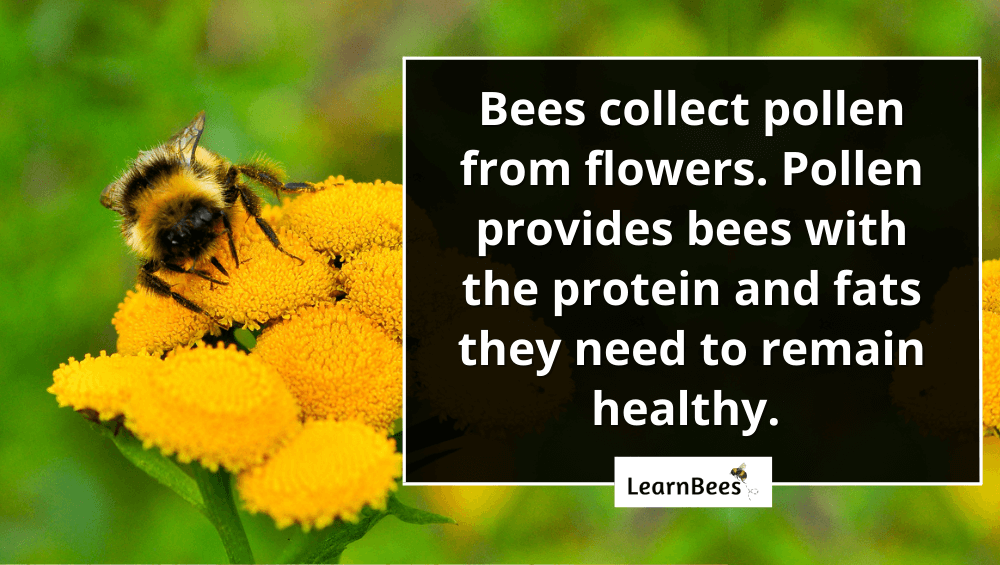
Bees use both pollen and nectar for food.
Pollen provides bees with protein and healthy fats. Much like how meat, poultry, fish, and eggs do the same for humans.(1)
On the other hand?
Nectar provides bees with carbohydrates that give them the energy to fly, pollinate flowers, and protect their nests.(2)
But what exactly is pollen, you ask?
Pollen is a powdery yellow substance that comes from plants. The spread of pollen helps to fertilize plants to produce seeds and fruit. As such, pollination helps to create the next generation of plants.(3)
But unfortunately, pollen can be tough for seasonal allergy sufferers.
But here’s the thing:
Bees need pollen to survive.
Unlike wasps, bees don’t eat other insects for food. Instead, they rely on flowers to provide them with the protein, carbs, and fats they need to thrive. So while pollen can be a massive hassle for people with allergies, it’s a vital part of a bee’s life.
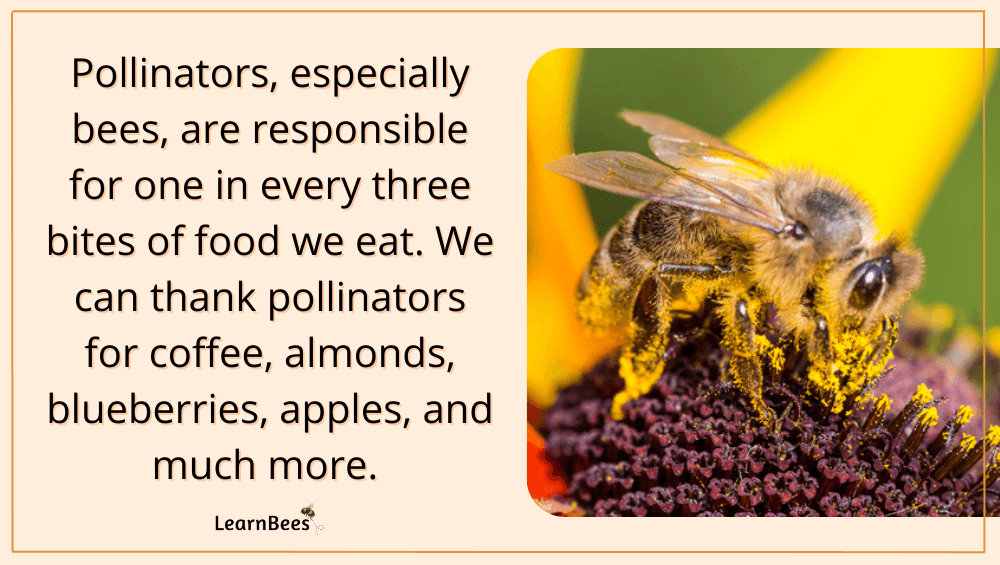
Pollinators are responsible for one in every three bites of food we eat. This means that bees directly affect foods like coffee, apples, blueberries, almonds, and much more.(4)
How do they do it?
Through pollination.
Remember:
Pollination is the act of moving pollen from one plant to another. This transfer of pollen leads to fertilization. As a result, such fertilization allows the plant to produce seeds that create the next generation of plants.
More importantly:
This is why bees are considered a keystone species. A keystone species is an organism that strongly impacts the ecosystem.(5, 6)
Without keystone species, the environment would be dramatically different or cease to exist altogether.
How Do Bees Get Pollen?
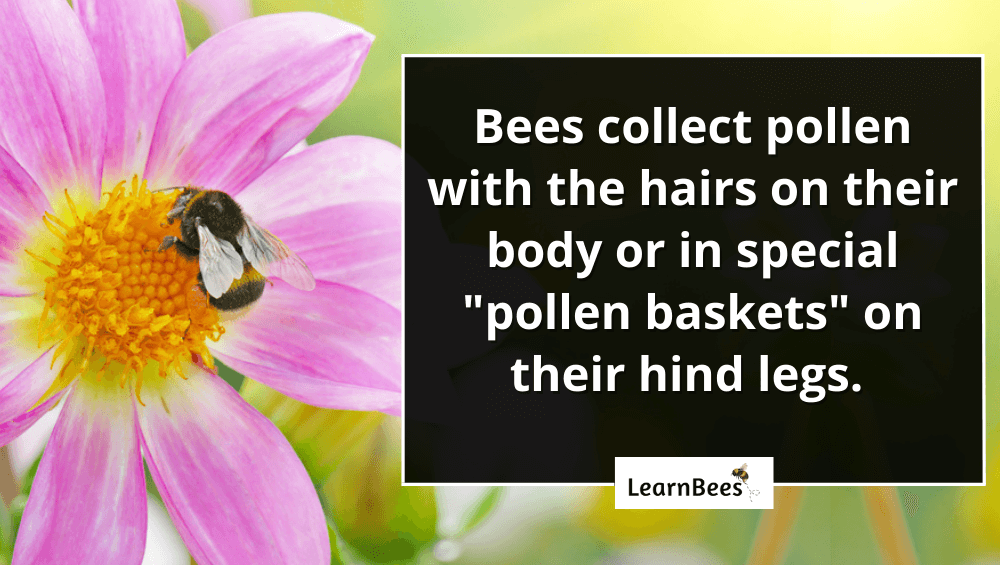
Bees use their sense of smell to detect plants that offer pollen and nectar.
Plants like salvia, veronica, and zinnias are bee magnets thanks to their rich pollen and nectar sources.
Interestingly enough:
Bees don’t eat pollen directly from the flowers.
Instead, they collect it on their legs and hairy bodies to return to the nest so they can eat it later. For example, mason bees get their fuzzy bodies covered in pollen by sort of “belly flopping” into the flower. This helps to shake the pollen out of the flower and coat the mason bee’s hair.
Some bees, like bumblebees, have unique “pollen baskets’ on their hind legs.
You guessed it.
Pollen baskets are storage pouches that bees use to carry pollen from flowers back to their nest. Once home, the bees mix their salvia and nectar with the pollen to form a “bee bread.”
Pollen, in its natural state, isn’t easily digestible by bees. So the bees turn the raw pollen into bee bread to eat it more easily. Bee bread looks like small yellow and brown pellets.
What Kind of Bees Collect Pollen?
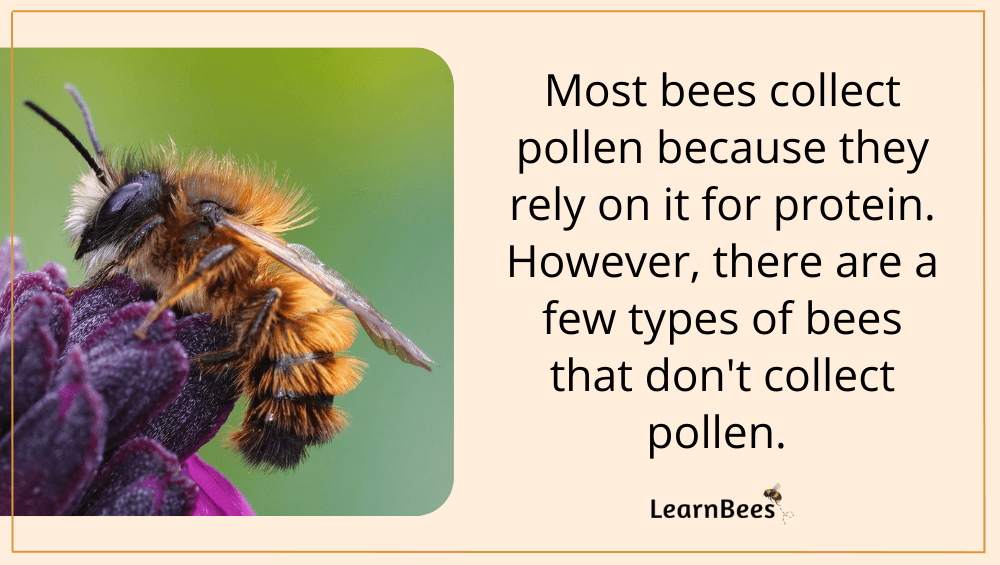
The short answer:
Most types of bees collect pollen.
This includes honeybees, bumblebees, carpenter bees, sweat bees, and so on.
As mentioned, bees rely on pollen and nectar for food. Pollen gives them a rich source of protein that they don’t get from other things. For example, bees don’t eat insects like wasps do.
Wasps prey on caterpillars, spiders, aphids, crickets, and other bugs. This helps keep the bug population under control.
But bees are different.
Their main diet is pollen and nectar from flowers. That’s why planting a bee-friendly garden can go a long way in helping your local pollinators. Flowers aren’t just for decoration. They’re crucial for the survival of bees and other creatures.
That said, there have been some bee species observed eating meat.
Vulture bees, for example, are a type of bee that gets their protein sources from dead animals and insects. Vulture bees (Trigona Hypogea) are native to South America. Because they eat meat, they don’t collect pollen like other types of bees do.
However, vulture bees are a rare exception because most types of bees rely on pollen and nectar for food.
FAQs on Pollen Bees
- What is pollen to bees?
- Is bee pollen just honey?
- Does pollen come from bees?
- Is pollen from bees good?
- How do bees remove pollen?
- Is bee pollen healthier than honey?
- What time of day do bees collect pollen?
- How long do bees collect pollen?
- Do all bees gather pollen?
- Is bee pollen the same as pollen?
- Does bee pollen clear skin?
- Can bee pollen upset your stomach?
- What happens after bees collect pollen?
- Do bees spread pollen on purpose?
What is pollen to bees?
Pollen is a crucial protein source for bees. Along with nectar, bees eat pollen to survive. Pollen gives them the nutrients they need to remain healthy, feed their young, and expand their nests.
So while pollen can be a nuisance during allergy season, it’s an essential part of a bee’s diet. Additionally, pollen allows plants to reproduce.
When bees collect pollen from flowers and spread it to other flowers, they help with the pollination process. Pollination is essential for plant reproduction. It allows the plants to create seeds that ensure the next generation of plants. It also allows food crops to bear fruit and other harvests.
—> Go back to the FAQs on pollen bees
More to Explore:
Is bee pollen just honey?
No, pollen and honey are two different things.
Honey is a sweet, syrup-like substance produced by bees and other insects. Pollen is a yellow powdery substance that plants rely on to produce seeds and fruit.
Honey is primarily made from the nectar of flowers and used as a food source for bees. Bees rely on honey when flowers are scarce, such as during winter or summer droughts.
For instance, flowers will begin to wilt and die during prolonged periods of droughts. This can spell bad news for the bees if they aren’t prepared.
Bees can store honey in their nests and use it as a food source during lean times. This helps them survive until conditions improve and flowers bloom again.
Pollen, on the other hand, is a powdery substance that contains the male reproductive cells of plants. Pollen is necessary for plant reproduction. When bees collect pollen from flowers and spread it to other flowers, they help with the pollination process.
—> Go back to the FAQs on pollen bees
More to Explore:
Does pollen come from bees?
No, pollen comes from plants – not bees.
Bees and other pollinators are responsible for transferring pollen from one plant to another. In turn, this allows the plants to make seeds that grow the next generation of plants. Pollination helps the plant life cycle.
Bees are solely attracted to plants for their pollen and nectar content.
In fact, you might be surprised to learn that plants make nectar to entice pollinators to their blossoms in the first place. So in many ways, nectar can be seen as a reward for pollination.
Bees collect pollen while slurping up the nectar with their tongue. The pollen sticks to their hairy bodies and spreads to other flowers as they fly around.
—> Go back to the FAQs on pollen bees
More to Explore:
Is pollen from bees good?
Pollen comes from plants – not bees. Bees don’t make pollen; they simply collect it for food.
That said, bees don’t eat pollen straight from the flowers. Raw pollen is simply too difficult for them to digest. Instead, bees mix pollen with nectar, saliva, and enzymes in their mouths. This creates a substance called “bee bread” that’s easier for them to eat.
Beekeepers often sell bee bread. It’s edible and can be eaten on its own or added to smoothies, granola, cereal, or other foods.
—> Go back to the FAQs on pollen bees
More to Explore:
How do bees remove pollen?
Bees collect pollen on their bodies, usually on their hair or legs. The tiny pollen particles stick to their hair due to electrostatic charges. The bees then use their legs to groom the pollen off their bodies.
For bumblebees and honeybees, they groom the pollen into special storage pouches known as “pollen baskets.” The pollen is then returned to the hive or nest, where it’s used for food.
Some bees, like many solitary bees, don’t have pollen baskets. They simply collect the pollen on the hairs of their hind legs or the underside of their abdomen.
More specifically, the “scopa” are dense hairs on a bee’s abdomen or hind legs. They’re especially visible in some kinds of bees, such as leafcutter bees.
—> Go back to the FAQs on pollen bees
More to Explore:
- Ground Bees: Are They a Threat to Your Yard?
- Wasps vs. Honeybees: Are They Different?
- Do Bumble Bees Bite?
Is bee pollen healthier than honey?
Both bee pollen and honey come with their share of health benefits.
For example, honey is rich in antioxidants that can help boost your immune system, prevent skin infections, and treat sore throats related to upper respiratory infections.
Bee pollen, on the other hand, is a source of vitamins, minerals, proteins, and lipids. It’s also rich in antioxidants and has anti-inflammatory properties. Some research suggests that bee pollen can help boost immune systems, offer some nutrients, and promote wound healing.
—> Go back to the FAQs on pollen bees
More to Explore:
What time of day do bees collect pollen?
Some research suggests that honeybees prefer to collect pollen in the morning.(7)
In general, bees are the most active during sunny and warm days. You’ll see fewer bees when it’s cool, rainy, or windy because such conditions can threaten bees.
For example, heavy raindrops can hit a bee and knock it off balance. Worse, heavy rain droplets can lead to a broken bee wing or leg.
Most bees are also diurnal (daytime) pollinators. They’re not nocturnal (nighttime) pollinators like bats, moths, and many beetles.
Depending on the type of bee, the season, and the latitude, bees can work from about sunup to close to sundown. It’s not unusual for bees to work 10+ hour days in some parts of the world where the climate permits it.
—> Go back to the FAQs on pollen bees
More to Explore:
- Do Carpenter Bees Pollinate?
- How Long Do Bumble Bees Live?
- Honeybees vs. Bumblebees: How Do They Compare?
How long do bees collect pollen?
Collecting pollen and nectar for food can be a bee’s full-time job.
Bees will work tirelessly to forage for food, often flying long distances. A single bee may visit hundreds of flowers in one day and collect pollen from each one.
With that in mind, bees are active during the warm seasons. For example, bees are most active in North America from late spring through early fall. This is when flowers bloom, and food is abundant for bees.
Once the weather starts to cool, and flowers begin to die off, bees will start to slow down their foraging. In some cases, they may even stop collecting pollen and nectar altogether.
Honeybees, for example, typically store enough food (pollen and honey) to get them through the winter. During this time, bees will stay in their hives or nests and not venture out.
However, in warmer climates, bees can remain active all year round if the temperatures stay consistent.
—> Go back to the FAQs on pollen bees
More to Explore:
- Do Queen Bees Eat Honey?
- Are Worker Bees Male or Female?
- Queen Bee Versus Worker Bees – How Do They Compare?
Do all bees gather pollen?
Not all bees collect pollen, but most of them do.
For example, a rare exception is the vulture bee. Vulture bees are a kind of bee that doesn’t collect pollen. Instead, they get their protein source from eating dead insects and animals.
Most bees, however, are pollen collectors. They use their hairy legs and bodies to transfer pollen from one flower to the next. This process is known as pollination, and it’s how bees help plants reproduce.
—> Go back to the FAQs on pollen bees
More to Explore:
- What Are Black Honeybees?
- Beehive on Ground: Are They a Problem?
- Bees Color: 10+ Types of Colored Bees With Pictures
Is bee pollen the same as pollen?
No, pollen refers to the raw pollen produced by flowers. It’s a yellow powdery substance, and it’s what most people are familiar with.
Bee pollen, on the other hand, is a yellow, brownish mixture of pollen, nectar, salvia, and sometimes honey. Bees can’t digest raw pollen from the flowers, so they make their own special mixture called “bee pollen,” which allows them to eat it.
—> Go back to the FAQs on pollen bees
More to Explore:
Does bee pollen clear skin?
While bee pollen has antibacterial and anti-inflammatory properties, it’s not a catch-all product for skin care. Other methods of clearing skin may be more effective and dermatologist-approved.
—> Go back to the FAQs on pollen bees
More to Explore:
Can bee pollen upset your stomach?
Most people experience no stomach sensitivities to bee pollen. However, start in moderation and discontinue eating it if it upsets your stomach.
—> Go back to the FAQs on pollen bees
More to Explore:
What happens after bees collect pollen?
They carry the pollen back to their hive to feed themselves and their young. In turn, they also help pollinate flowers while collecting pollen.
—> Go back to the FAQs on pollen bees
More to Explore:
Do bees spread pollen on purpose? What happens when bees spread pollen?
No, a bee’s role in pollination is what some would consider a “happy accident.” They’re simply trying to collect food for themselves and their family. But in the process, they fertilize plants, which play a massive role in the ecosystem.
